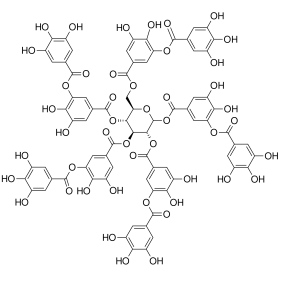The Naturopathic Herbalist
Tannins are produced to a greater or lesser degree by all plants, with higher concentrations in those tissues which are lost by plants such as leaves, fruits & bark. An easy way to remember what tannins are and what they do in the body, is to pour yourself a glass of wine. Feel your tongue get fuzzy and dry. Those are tannins at work!
Tannins are polyphenolic compounds that contract and “astringe” tissues of the body by binding with and precipitating proteins – hence their use to “tan” leather – combining with them, and thus rendering them resistant to proteolytic enzymes.

Tannic Acid (a typical polyphenol of indeterminate structure)
Pharmacology of Tannins
Tannin-containing herbs are used to tighten up tissues (varicose veins), dry up excessive watery secretions (diarrhea), protect damaged tissue (skin), help to stop bleeding (heavy menstrual flow) and to keep infection in check.
They also act to inhibit enzymes such as 5-lipoxygenase & hyaluronidase, lending to their action as anti-inflammatories, antimicrobials & keratolytics.
Chemically tannins are phenols based on the benzene ring with a hydroxyl group attached. They are soluble in water, and will precipitate alkaloids, nitrogenous bases and some glycosides when combined with other herbs in tincture form. (Note: tannins are often used to antidote alkaloid poisoning).
Much ingested tannin remains unabsorbed in the digestive tract, but some does reach body fluids as soluble tannate to be excreted by the kidneys.
Classes of Tannins (Condensed & Hydrolyzable)
1) Condensed tannins & Proanthocyanidins (di-hydroxybenzenes such as catechol) are extremely common in nearly all plants. They are flavonoids and anthocyanidin precursors (what gives coloured pigments to plants), and are especially prevalent in fruits, foods, and the Rosaceae family.
When taken internally condensed tannins cause precipitation of the cells lining the gut, thus inhibiting cellular secretions and reducing the absorption of substances across the gut wall. This action also leads to reduced sensitivity of nerve endings in the gut, thus reducing peristalsis and making tannins useful in the treatment of diarrhea, especially when due to an infectious cause, as the bacteria in the gut will also be precipitated. Applied externally they are very useful in treating burns, as they precipitate protein of the exposed tissue to help form a scab. Some herbal examples of condensed tannins include:
2) Hydrolysable tannins (HTs) (or tri-hydroxybenzenes) are broken down readily by acid, alkali or certain enzymes to yield gallic or ellagic acid, and ultimately pyrogallol which is antiseptic, caustic and hepatotoxic. Thus, HTs should be used with caution and if taken internally it should be for the shortest time possible. Some herbal examples of hydrolyzable tannins include:
- Arctostaphylos uva-ursi (Bearberry)
- Aesculus hippocastanum (Horsechestnut)
- Hamamelis virgininicus (Witch Hazel)
- Quercus sp. (Oak)
Tannins & Tissue Specificity
Tannins also demonstrate the amazing phenomenon of tissue specifity, whereby their astringent action may act locally, or at a distant site within the body. Astringent Herbs with tissue specificity to various body systems may include:
Hemostatics:
- Achillea millefolium (Yarrow)
- Aesculus hippocastanum (Horeschesnut)
- Capsella bursa-pastoris (Shepard’s Purse)
- Hamamelis virginicus (Witch Hazel)
Gastrointestinal Tract:
- Filipendula ulmaris (Meadowsweet)
- Geranium maculata (American Cranesbill)
- Camellia sinensis (Green/Black Tea)
Renal:
Pulmonary:
Cardiovascular:
Female Reproductive:
Safety Concerns with Tannins:
- The use of tannins is contraindicated or inappropriate in cases of constipation, iron deficiency, and malnutrition
- Tannin rich herbs may reduce the absorption of alkaloids and other basic drugs through precipitation when combined in a formula together.

Comments are closed.